main: September 2008 Archives
My wonderful neighbor Anthony, whose fisherman expertise is matched by his passionate, sensible defense of the aquatic ecosystem, came to my door at 5 p.m. carrying a paper plate. Upon it sat a beautiful spotted gray and rose fish, beheaded, slit, gutted, and garnished with large commas of roe the color of ripe pumpkin. "This was swimming a half-hour ago," he said, smiling shyly. "Are you sure?" I asked, referring to the gift, not his veracity. 
I'm a New Yorker who lives in the
I was weekending in Bellport, Suffolk Country, when my neighbor knocked, and he said he caught a half-dozen at nearby
Grill? Pan-fry? I couldn't remember the last time I had cooked a trout. My fish, I realized, has been absent from dinner-party tables and most restaurant menus for a while. Smoked trout, a wisp of arugula, fine. Trout almondine, truite au bleu? Get your great uncle to reminisce about wooing your great aunt at a late trout supper after the curtain went down on East Lynne, holding her soft hand under the table as the deft waiter lifts away a comb of bones. Then, trout signified not only the plaid-male outdoors but tablecloth civilization in effete French form -- along with escargot, celery remoulade, and sinful mousse au chocolat. Few foods, in fact, have been as culturally bisexual as trout. So why has it vanished from its once unimpeachable place?
What a coincidence that I had seen trout play its accustomed role just last night, in Robert Altman's 1993 Short Cuts. The satisfying film was done in the director's signature format of overlapping stories (these by Raymond Carver) with common themes -- in this case, frustrated ambition coupling with disabled affection. One segment has an unemployed
They leave her there for days so their sport won't be ruined.
One after the other yanks up a thrashing trout (couldn't tell which kind), fish whose flesh is suffused with the water in which the neglected Ophelia decomposes. Trout fishing in Altman's
Trout has been farmed since the first of this nation's forebears could dig a pond. Wild trout are masculine, hatchery trout feminine in the cultural imagination. The difference in taste is similar to that between wild and farmed salmon, the latter flabby in comparison. "Trout" is a great rhymer: spout, kraut, doubt, flout. At a flea market long ago I found a black-rayon pajama top upon which fat trout in surreal color leapt from the bubbles of a fabric stream; I searched for years for the matching bottoms.
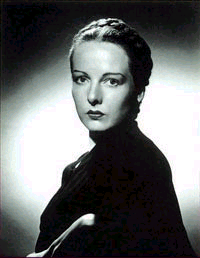 Those who routinely read about better food than they usually eat will recall M.F.K. Fisher's tale of enthrallment by the "wild-lipped" fanatical waitress at an old-mill restaurant in northern
Those who routinely read about better food than they usually eat will recall M.F.K. Fisher's tale of enthrallment by the "wild-lipped" fanatical waitress at an old-mill restaurant in northern
"Oh, the trout!" She sounded scornful. "Any trout is glad, truly glad, to be prepared by Monsieur Paul. His little gills are pinched, with one flash of the knife he is empty, and then he curls in agony in the bouillon and all is over. And it is the curl you must judge, Madame. A false truite au bleu cannot curl."
That particular sapphired victim was immortalized first by the chef, and doubly by the author, who wrote her account in 1937. In it lies some of the answer to our question, because at the time Fisher was sampling the culinary personality of
My hot trout sits on a plate, waiting.
For an automatic alert when there is a new Out There post, email
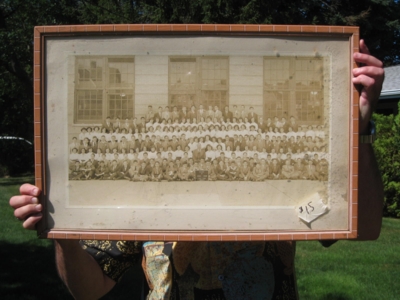
I'll never know why didn't he snap up the vintage photo of Public School 238's eighth-grade graduating class. He had a really good reason to do so -- but maybe an even better one to leave it be.
Who can doubt that flea markets are museums?
Yard and garage sales are those museums' feeder galleries, and all of them provide a surprise immersion into the lives that neighbors past and present have led. Those of us who are hypnotized by these object lessons in popular culture also understand that the rich discards displayed for sale have soaked up buckets of emotional juice -- some actually vibrate with survival after years of use and handling.
You may be stopped cold by one of these items, petrified by its story.
Faithful yard-salers, even the most blithe or cynical, will recognize each particular madeleine, be it the ceramic ashtray identical to the one your dead father filled or the old postcard of a pastel hotel you happened to have stayed in when, as a tan young man, you discovered the salty taste of a stranger's kiss.
I can't remember at which parking lot or upon what lawn I found the sepia graduation photo of the "Class of June 1949, P.S. 238,
That photo, though of a much earlier class, still pushed me to recall the names of my teachers: third grade's plump, encouraging Mrs. Horween; the disgusting Mr. Barash, who clipped his nails at his desk and never answered questions; the wondrous Miss (Jane) Costello, whose clearheaded kindness and direct intelligence I will never forget. You probably don't care to read about how she passed around Halloween apples with hidden coins stuck in them, pennies in the large ones, nickels in the littlest, to make her modest moral point. I can still hear her calm voice, see her generous gray-blue eyes. That's my treasure, not for sale.

Selling Day
So, the photograph under glass in its ridged wooden frame is propped against a box on a lawn, part of our yard sale, along with more than a hundred material friends.
The day, hot as blazes, goes by quickly as folks stroll among the stuff. Some shoppers are grim, even offended. "That '10' is dollars? Should be cents!" one shouts, referring to a Mexican tourist-ware candelabrum of inlaid brass. Others are genial and happy to finger whatever's in front of them.
An older man and woman come by. They are somewhat sloppily dressed for their age, though their car is hybrid and expensive. She picks up a single dish with an ugly floral rim and turns it over. "I know who designed this. Now what was his name?" she asks aloud. I had a dollar on it, a steal.
Her companion lifts the school photo.
"That's from Midwood,
"I know."
How does he know?
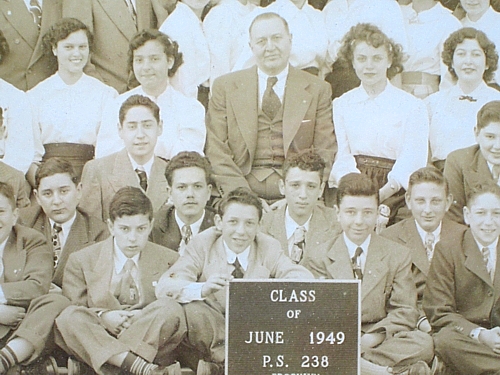
"I went there," I add.
A pause.
"So did I."
No, that can't be. I get up and walk over, wondering how old I look, at least compared to him. "What class were you in?" I ask.
He doesn't acknowledge me, so I move away, not wishing to disturb or pressure him.
"This one. This is my class."
With that, his companion and I rush over to watch him examine what he's holding.
"That's me," he says, matter-of-fact, as he places his finger on a dark-haired boy in the back row, third from the left. I steal a glance at this man beside me, at his tired eyes, his dull hair, and then down at 1949. Yes, a resemblance is easy to imagine.
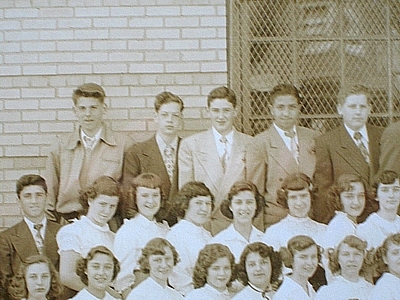
"That's me" (top row, center)
He then points to three or four different faces, boys only, and names them -- Jewish- and Italian-sounding, I think, but it's a shame I can't remember exactly.
Talking mostly to himself, he explains that the school didn't want to let the fellow on the end of his row be photographed because he had arrived with a casual jacket on, not a proper suit or sportcoat. Yet for some reason they relented, as we can see -- which seems to amuse him. Then his expression sours, and he puts the photo on the ground.
"It was Frederick Rhead," she cries, suddenly remembering who designed the small ivory plate that she identified from the backstamp. "He taught at Pratt. I went to Pratt."
Rhead is an English-born potter and designer who came to the
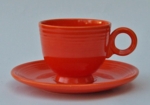 I had no idea Rhead was at Pratt; he died in
I had no idea Rhead was at Pratt; he died in The Pratt student buys the plate, at full price, and both begin to walk to their car. I'm confused.
"You don't want the picture?" I call out. What are the odds of such a perfect meeting between subject and object? It's only $15, but I'd give it to him free, with my blessing. Objects have natural homes, and they should go where they belong.
He turns to me, and on his face is a look I still cannot fathom: a disturbing blend of disinterest and discomfort. He says nothing, and they leave.
School Days
Later, after the lawn is cleared and orphans boxed for donation, I try to understand what happened. Logically, my visitor was probably telling the truth, but if not, what a creative liar he was: spotting that errant boy in the gabardine top and riffing on his plight, swiftly inventing names, and best of all, pointing at a random young man he claimed to be himself. Which of all those smiling faces would you choose to be you?
No, that must have been him, almost 60 years ago. So why didn't he carry it home?
He already had one. He didn't like "things," and his magpie wife kept loading their nest with uselessness. He avoided photos -- some do, for a variety of reasons, especially photos of themselves. He was bullied in school and hated that part of his life. He was in love with a girl in the class photo who rejected him meanly, to his everlasting anger and regret. He was in love with the gentle boy beside him, the one with the glasses to his right, but soon after graduation he found out that this adored buddy preferred that guy in the wrong jacket who shouldn't have been in the picture at all.
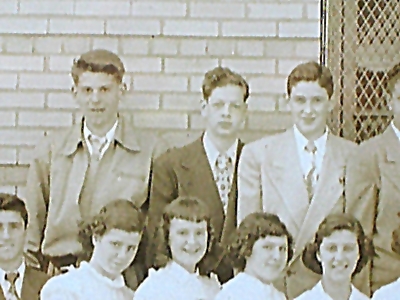
Names are rarely exchanged at yard sales. Reader, do you know anyone in the P.S. 238 photo, or is it possible that you may compound an already impossible coincidence by identifying yourself?
For an automatic alert when there is a new Out There post, email
